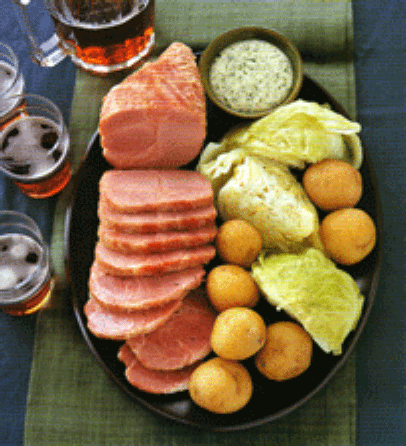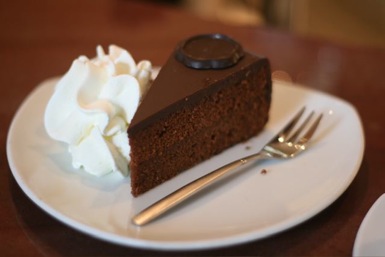|
Recipes
Beef and Yorkshire Pudding Canapés
This
is a lovely and quick appetizer to serve to a gathering of friends.
Very much like Sunday roast beef dinner in a bite! There are two
flavoring options–horseradish and mustard.

Ingredients
For the Yorkshire puddings
§
1 cup flour
§1/4
tsp. salt
§
1 cup milk
§
2 eggs, beaten
For the horseradish cream
§
1/2 cup non-fat Greek yogurt or non-fat sour cream
§
2 tbsp. prepared horseradish
§
salt and pepper
For the mustard cream
§
1/2 cup non-fat Greek yogurt or non-fat sour cream
§
2 – 3 tbsp. Dijon mustard
§
salt and pepper
For the filling
§
12 slices of thinly shaved roast beef
§
flat leaf parsley, to garnish
Makes at least 24
Method
1.
Preheat oven to 450 degrees F.
2.
Add a very thin layer of vegetable oil in each cup of a 24 mini
muffin tins and heat in the oven.
3. To
make the Yorkshire puddings, blend the four and salt, gradually
whisk in the milk to ensure no lumps, then add the eggs.
4.
When the tray is hot, spoon in the batter in each muffin tin and
return to the oven. Watch carefully, and cook for about 8-10
minutes until the mixture has puffed up and has browned. Then let
cool on a wire rack.
5. To
the make horseradish cream, simply mix the ingredients together. To
make the mustard cream do the same.
6.
Tear each slice of roast beef in half. Loosely wrap into a rose
shape and pile on each of the baby Yorkshire pudding. Add a dollop
of horseradish cream to half of the canapés, mustard cream to the
other.
Decorate all with a sprig of flat leaf parsley, tray and serve at
room temperature.
Irish
Dinner
We celebrate the
Emerald Isle with a traditional Irish meal! Our main dish will be Irish Bacon and Cabbage. In Ireland, only the leg of the pig is
called “ham” (it’s also called “gammon”); otherwise, the cured meat
is bacon. Ask someone who hasn't lived in or visited Ireland about
Irish food, and nine times out of ten they'll mention corned beef
and cabbage. However, while corned beef and cabbage is sometimes
eaten there, it's probably eaten a lot less than most people
imagine.
Irish Bacon and Cabbage. In Ireland, only the leg of the pig is
called “ham” (it’s also called “gammon”); otherwise, the cured meat
is bacon. Ask someone who hasn't lived in or visited Ireland about
Irish food, and nine times out of ten they'll mention corned beef
and cabbage. However, while corned beef and cabbage is sometimes
eaten there, it's probably eaten a lot less than most people
imagine.
From the earliest
historical times pork was always the favorite meat dish in Ireland.
Cattle were only slaughtered when they were no good any longer for
milking, or for breeding purposes; otherwise, they were prized as a
common medium for barter. The size of one's herd of cattle was an
indication of status, wealth and power. Eating beef, except for that
of a cow past its milking days or accidentally killed, was the
cultural equivalent of lighting your cigars with hundred-dollar
bills...unless you were a chieftain, or a king, in which case you
could afford it.
In later centuries,
the majority of Irish people still didn't eat very much beef --
because it was much too expensive. Those who did eat beef, tended to
eat it fresh: corned beef again surfaces in writings of the late
1600's as a specialty, a costly delicacy (expensive because of the
salt) made to be eaten at Easter, and sometimes at Halloween.
Then other factors,
tragic ones, made beef even rarer in the Irish diet - the Great
Famine.
Many Irish, during
that period, hardly ever got a taste of beef until after they
emigrated to America or Canada, where both salt and meat were
cheaper. There, when they got beef, they treated it the same way
they would have treated a "bacon joint" at home in Ireland: they
soaked it to draw off the excess salt, then braised or boiled it
with cabbage, and served it in its own juices with only minimal
spicing (a bay leaf or so, perhaps, and some pepper).
It's almost impossible
to mention Ireland and not think of the potato. Its dominance as a
food was a major contributor to the plight of the Irish people
during the Great Famine of the mid 1840's. This scrappy,
grow-anywhere tuber has its origins in South America. It has been
estimated that as long as 13,000 years ago the wild potato grew in
the coastal areas of Chile. Seven thousand years ago the Andean
people were growing the potato as a crop, something the Europeans
didn't do until some 30 years after the Spanish "discovered" it in
1536. The now ubiquitous tuber was considered a lowly, common food.
That the potato was
viewed by Europeans as a food for the lower class is somewhat
ironic. In time the potato would become more valuable than the gold
and silver that the Spanish were searching for. Worldwide the potato
harvest has been pegged at $100 billion.
When Columbus returned
to Spain from his 1492 voyage one of the gifts he brought back for
King Ferdinand and Queen Isabella was the sweet potato. Oddly
enough, this new world root caught on well with the royals and they
may have even had gardens of sweet potatoes planted. It was their
son-in-law King Henry the VIII who brought it to England, reportedly
for its presumed use as an aphrodisiac.
It took the Irish
people to recognize the "other" potato as a food staple in Europe.
In the 1640's potatoes were being planted in
Ireland and twenty-five years later were already a back-up crop with
the ability to supplement their diet in time of shortages. If the
grain crop failed the potato crop picked up the slack. The potato
loves Ireland and the wet weather its western countryside provides.
If an unusually wet season destroyed the grain crops by flooding,
the thirsty potato thrived. In time the Irish diet became more and
more dependent on the potato.
This dependence was to
turn to disaster in the first mass famine of 1740 when the grain
crop failed and the winter was so cold it froze the potatoes in
storage. One-hundred years later, during the seasons of 1845-49, it
was the blight which was wreaking havoc on the potato crop causing
the Great Famine killing tens of thousands and driving many
thousands more to emigrate. It wasn't until 1911 when a blight
resistant strain of potato was developed. The Irish call potatoes "praties;"
and according to food experts, a diet of potatoes and milk will
supply all the nutrients the human body needs. The potato has long
been considered a staple for the poor, and throughout their often
difficult history, impoverished Irish people have relied heavily on
it for subsistence. Potatoes contain plentiful carbohydrates and
some protein, calcium, and niacin. They are easy to grow and store.
Our traditional meal would not be complete without including a
favorite Irish potato recipe – chives champ!
Irish Bacon and Cabbage
(Serves 14-16 people)
7-8 pounds
Irish boiling bacon (shoulder or collar)
2 heads cabbage, cored and quartered
 Parsley
Sauce Parsley
Sauce
8
tablespoons unsalted Kerrygold Irish butter
6 tablespoons all-purpose flour
½ cup bacon cooking liquid
2½ cups hot milk
Salt and freshly ground pepper to taste
1 cup minced fresh flat-leaf parsley
Whole-Grain Mustard Sauce

4
tablespoons unsalted Kerrygold Irish butter
2 small onions, chopped
2 cloves garlic, minced
4 teaspoons whole-grain mustard
1⅓ cups dry white wine
1 cup bacon cooking liquid, plus more as needed
2½ cups half-and-half, plus more as needed
Salt and freshly ground pepper to taste
- Put the bacon in a
large saucepan and cover with cold water. Bring the water
slowly to a boil, then cover and reduce the heat to medium-low.
Simmer, skimming the water occasionally to remove the foam, for
about 30 minutes per pound, or until the meat is tender when
pierced with a fork.
- About 20 minutes
before the bacon is cooked, add the cabbage. Cook for 15-20
minutes, or until the cabbage is tender, but not soggy.
Transfer the bacon to a serving dish, and let cool for 20
minutes before slicing. Drain the cabbage, reserving 1½ cups of
the cooking liquid for the sauces, and transfer to a serving
dish.
- To serve, slice the
meat and serve it with the cabbage.
To make parsley
sauce:
In a small saucepan over
medium heat, melt the butter. Gradually stir in the flour. Cook
for 1 to 2 minutes, or until blended. Slowly stir in the cooking
liquid, then the milk. Bring to a boil and cook, whisking
constantly, for 3 to 5 minutes, or until slightly thickened. Add
the salt, pepper and parsley and cook, whisking constantly, for 3 to
4 minutes more, or until the sauce is smooth. Serve warm.
To make the whole
grain mustard sauce:
In a saucepan, melt the
butter over medium heat. Add the onion and garlic and cook until
soft. Stir in the mustard and wine and cook for 2 minutes. Add the
cooking liquid and half-and-half and cook, whisking constantly, for
5 to 7 minutes, or until reduced by half. Add the salt and pepper
and cook for 5 minutes, or until the mixture has a creamy
consistency. Add more boiling liquid or half-and-half, if needed,
to make a smooth sauce. Serve warm.
Chives Champ
6 pounds
of potatoes
1 cup chives
4 cups milk
Salt and pepper to taste
Butter
Boil the potatoes in
salted water until tender. Drain. Return to the stove and toss
gently over low heat to dry. Meanwhile, bring milk and chopped
chives to a simmer. “Beetle” or mash the potatoes. Add milk
mixture gradually. Season with salt and pepper to taste and
continue beating until of good consistency.
Serve hot with butter in
the center of each mound. Everyone gets a portion, makes a hole in
the center and into this puts a large lump of butter. The champ is
eaten from the outside with a fork, dipping it into the melting
butter.
Austrian
Dessert
We are still dreaming about
our cruise through Austria on the Danube River and thought
about the yummy dessert, Sachertorte, which can be found in many of
Vienna’s coffeehouses. We remembered that we had a great recipe for
this from the gourmet dinner group we used to belong to. So, here
it is! Enjoy!

Sachertore
(pronounced “SOCCER tort”)
Ingredients:
Cake Ingredients
½ cup soft unsalted butter
1 cup sugar
6 egg yolks
6 ounces semi-sweet chocolate, melted and cooled
1 cup apricot preserves or jams
4 tablespoons cold water
8 egg whites
1 cup sifted flour
2 tablespoons cocoa
2/3 cup heavy cream to whip and serve with cake
Chocolate Frosting
½ cup sugar
2 teaspoons corn syrup
6 ounces semi-sweet chocolate pieces
¾ cup heavy cream
3 tablespoons butter
1. Cream butter and ¾ cup sugar until very fluffy. Add the egg yolks
one at a time. Beat well after each addition.
2. Melt chocolate in a double boiler or microwave. Cool mixture and
add the butter mixture. Blend well.
3. Combine the flour and cocoa.
4. Beat the egg whites until soft peaks appear (for better results,
add a pinch of cream of tartar). Add ¼ cup sugar, 1 Tablespoon at a
time, beating the whites until they are very stiff. This will take
about 5-7 minutes depending on the type of beater used.
5. Fold 1/3 of the flour-cocoa mixture into butter mixture; then
fold in 1/3 of the egg whites. Continue folding in alternately flour
and egg whites. Fold rather than mix very lightly.
6. Butter well two 9 inch cake pans and line the bottoms with wax
paper; butter the paper and dust with flour.
7. Preheat the oven to 350 degrees. Pour the batter into pans and
bake for 30-35 minutes or until a toothpick inserted in the center
of the cake comes out clean. Cool the cakes for about 10-15 minutes
and take out of the pan. Remove the wax paper. Don’t refrigerate.
8. Prepare the apricot glaze. Mix the apricot jam or preserves with
water in a saucepan. Simmer for 2 to 3 minutes. To glaze the cake,
place the bottom layer top side down on plate. Spread the glaze
evenly over the cake. Place the second layer on top and spread the
remaining glaze on the surface.
9. In a heavy saucepan, combine chocolate, cream, sugar and corn
syrup and simmer the mixture, stirring frequently, for about 15
minutes. Remove from the heat and add the butter. Use a wooden spoon
and beat the frosting for about five minutes against the side of the
pan until it cools. Make sure the frosting is smooth and shiny and
still soft enough to spread.
10. Dip a knife in cold water and then smooth the frosting over the
cake. After an hour or so, the frosting will begin to set. The
frosting that has dripped down the sides may be pressed back against
the sides of the cake. The frosting will be set in 2 to 3 hours.
Serving Suggestion:
Traditionally, a slice of Sachertorte is served with a side dollop
of whipped cream. The cream may be served in a side dish.
|